GERMANY
Plants and Animals

Plants and Animals

Cities in GERMANY
| Berlin | Cologne | Dortmund |
| Frankfurt | Hamburg | Heidelberg |
Popular destinations GERMANY
| Bavaria |
Plants and Animals
Plants
The German flora belongs to two plant geographic provinces of the Eurosiberian region: in the extreme northwest to the Atlantic province and in the rest of Germany to the Central European province. The alpine vegetation of the high mountains is a separate sector. Germany's national flower is the cornflower or bachelor's button (Kornblume or Zyane in German).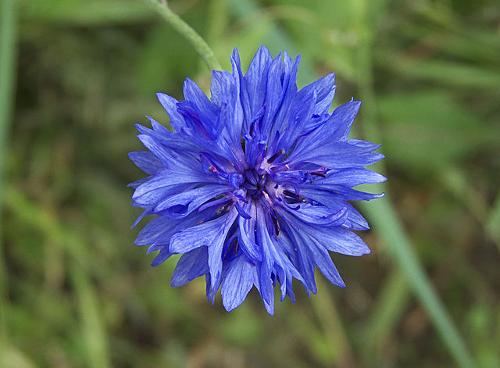 Cornflower, national flower of GermanyPhoto: Rasbak CC 3.0 no changes made
Cornflower, national flower of GermanyPhoto: Rasbak CC 3.0 no changes made
The natural vegetation consists predominantly of forest, with the exception of a saline strip along the coast, drifting dunes, living high moors and the mountains above the tree line. At the beginning of our era, Germany was still covered for approx. 75% with forest, in 1800 only for approx. 20% and at this time again for approx. 30% through reforestation. Two thirds of the forests consist of coniferous wood, especially pine and spruce.
The deciduous forest consists mainly of oak hedge-beech forest (with oak, hornbeam, beech, wild cherry, ash, maple) on nutrient-rich soils in the low plains; beech forest in the Atlantic and Baltic lowlands, in the hilly area and the beech belt of the mountains situated under the spruce belt; oak birch forest on nutrient-poor soils in the low plains; alder and willow forest in the swamps; willow forest and ash-elm-bird cherry forest in the floodplains of the rivers.
Germany also consists for approx. 14% of nature areas with vegetation types including heaths in the northwest, especially in high moors in the mountains. Marshes mainly in the south of Bavaria and Württemberg and in the north-east, rocky vegetation, thickets and locally the remarkable sparse vegetation of soils rich in zinc or lead.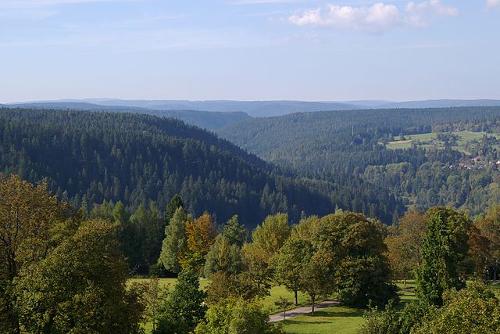 Black Forest, wooded area in GermanyPhoto: Rainer Lück CC 3.0 Unported no changes made
Black Forest, wooded area in GermanyPhoto: Rainer Lück CC 3.0 Unported no changes made
Until the early 20th century, the semi-natural landscapes, such as barren and extensively grazed grasslands, heaths and hay marshes, still played an important part in the vegetation of Germany. Due to revolutionary changes in agricultural culture, these ecological communities, which have remained stable for centuries, have been reduced to a few remnants and, moreover, they have been redeveloped or gone wild, which has led to a considerable impoverishment of flora and fauna.
A lot of heather occurs in swamp areas, on peat soils and in the humid forest areas of Northern Germany. Sea lavender is resistant to the salty coastal environment and grows mainly along the German North Sea coast. Sea thistle is a common plant in the dunes and the endangered yellow plump is found in the Rhine basin and the lower Elbe. Water lilies float on lakes and water conservation basins.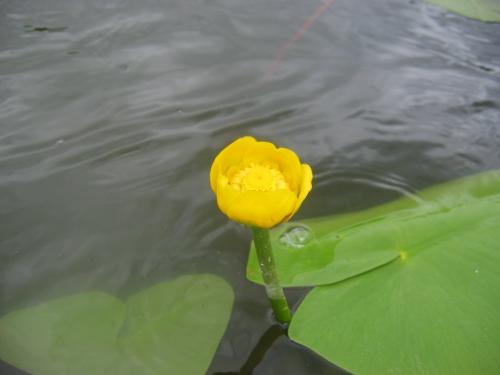 Yellow water-lilly or brabdy-bottle, endangered aquatic plant in GermanyPhoto: Kristian Peters Fabelfroh CC 3.0 Unported no changes made
Yellow water-lilly or brabdy-bottle, endangered aquatic plant in GermanyPhoto: Kristian Peters Fabelfroh CC 3.0 Unported no changes made
The yellow iris is also a protected plant species that usually grows between reeds or in moist wooded areas. In beech and pine forests we find the well-known holly, often used at Christmas.
In the Alps, the gentian is one of the most beautiful appearances. The famous edelweiss grows high in the Alps.
Animals
The animal world is very similar to that of the Netherlands and Belgium, at least as far as the north and west are concerned; in the east, the fauna matches that of Eastern Europe and in the south (Bavaria) that of the Alps.
The here and there still extensive forests provide shelter for deer, numerous wild boars and wild cats, largely due to good hunting management.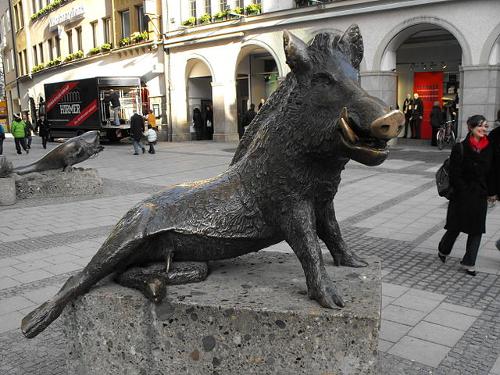 Statue of a wild boar in front of the Jagd- und Fischereimuseum in Munich, GermanyPhoto: Biso CC 3.0 Unported no changes made
Statue of a wild boar in front of the Jagd- und Fischereimuseum in Munich, GermanyPhoto: Biso CC 3.0 Unported no changes made
The fox, badger, marten and otter occur in suitable biotopes. The red deer and roe have been able to survive thanks to excellent hunting laws. The moose has been reintroduced in some Baltic Sea areas and elsewhere this is also the case for fallow deer, sika deer and mouflon. Hare and rabbit are common, just like many other small rodents, including the squirrel, the hamster, and the so-called dormouse (including the dormouse). The muskrat has entered Germany from Bohemia and has expanded significantly in a northwestern direction. The beaver has been able to survive in the Elbe, among other places.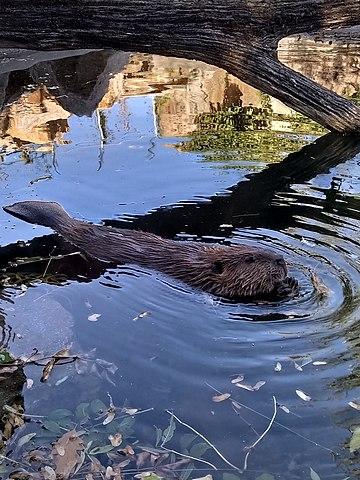 Swimming beaver near Stuttgart, GermanyPhoto: Gerbil CC 4.0 International no changes made
Swimming beaver near Stuttgart, GermanyPhoto: Gerbil CC 4.0 International no changes made
The common seal lives on the North Sea coast, the stink seal on the Baltic Sea coast. Harbor porpoise and bottlenose dolphin are fairly common occurrences in the coastal areas. The bird world is a typical Western European with some alpine species (e.g. alpine chough, rock creeper and snow grouse). Special bird species include the capercaillie, the hazel grouse, the raven, the great bustard, the crane, the black stork, the golden eagle, the white-tailed eagle and the eagle owl.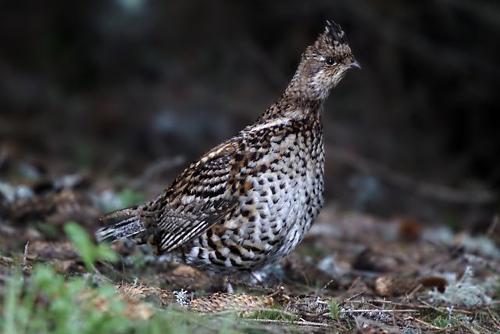 Hazel grouse, GermanyPhoto: MichaelHaeckel CC 3.0 Unported no changes made
Hazel grouse, GermanyPhoto: MichaelHaeckel CC 3.0 Unported no changes made
Among the reptiles, mention can be made of the European pond terrapin, many types of lizards and snakes, including the esculap snake and the dice snake. Special amphibians are the alpine and fire salamander. Salmon has virtually disappeared from the Rhine as a result of water pollution. Population growth, urbanization and industrialization have greatly reduced fauna.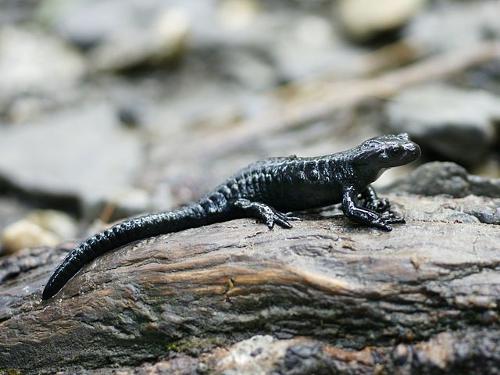 Alpine salamander, GermanyPhoto: Böhringer Friedrich CC 2.5 Generic no changes made
Alpine salamander, GermanyPhoto: Böhringer Friedrich CC 2.5 Generic no changes made
In 2015, for the first time in Europe, a population of cave fish, of the genus Barbatula, ray-finned fish from the verge family, was spotted. This fish, occurring in southern Germany (Swabian Alb), is also the most northerly cave fish ever found.
Sources
Ayer, E.H. / Germany
Lucent Books
Egert-Romanowska, J. / Duitsland
Van Reemst
Europese Unie : vijftien landendocumentaties
Europees Platform voor het Nederlandse Onderwijs
Mark, D.F.W. van der / De Bondsrepubliek Duitsland voor en na 1990 : geschiedenis, politiek, economie en ruimtelijke ontwikkeling
Landensurveys
Tatsachen über Deutschland
CIA - World Factbook
BBC - Country Profiles
Copyright: Team The World of Info